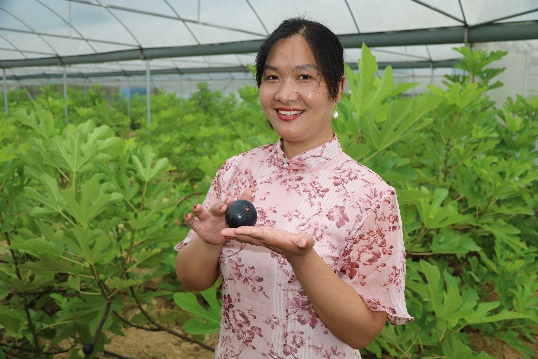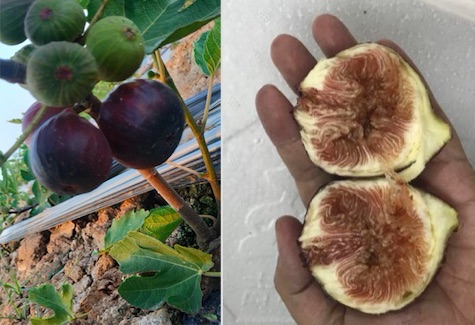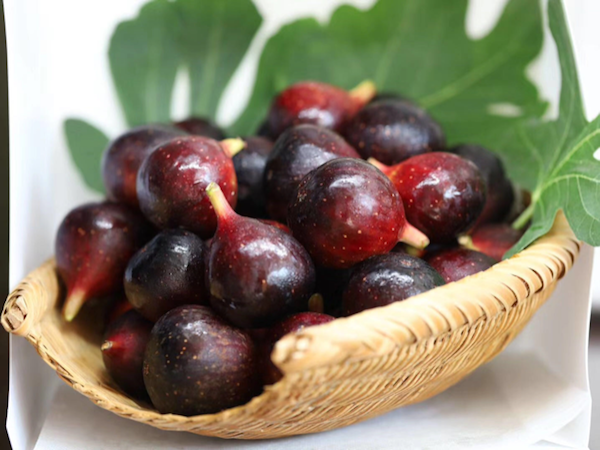Fig production areas in China are widely distributed and the annual production volume is huge. The product quality of Chinese figs depends on product variety and production area. China has a long history of growing figs and cultivation technology improves every year, but many production areas struggle to get the flavor right and make the figs suitable for storage.
In the end, suppliers have difficulty obtaining a good price. Red figs, for example, are produced on a large scale in east China, Yunnan, and south China. Ripe figs easily spoil in storage, so farmers have to harvest them before they are completely ripe and sell them like that. In addition, high temperatures prevent some fig trees from hibernation, which has an impact on the figs. These figs develop hollow cores and that affects the product quality.
 Ms. Chen Junmiao of Beijing Natural Fruit Beauty Agricultural Development Co., Ltd. visits their ‘purple diamond’ fig plantation
Ms. Chen Junmiao of Beijing Natural Fruit Beauty Agricultural Development Co., Ltd. visits their ‘purple diamond’ fig plantation
The ‘purple diamond’ fig officially entered the Chinese market under these circumstances as their development reached the commercial stage. The production season of this variety is adjusted with plantation technology so that each fig tree can be harvested twice per year.
The first harvest takes place between June and August, and the second between October and January in the subsequent year. This greatly improves product quality and production volume. The ‘purple diamond’ fig variety was cultivated in the horticultural research department of the Guangxi Agricultural Science Institute. The new variety was first planted in a greenhouse where the fig was subjected to five years of experimental cultivation. The ‘purple diamond’ fig is highly resilient and therefore suitable for storage. However, the fig tree can also bear fruit under relatively low temperatures.

‘Purple diamond’ figs
“The ‘purple diamond’ figs are harvested when they reach 85% of ripeness and can be kept in storage at 5 degrees Celsius for 7-10 days. When other figs are kept under similar conditions, they only last for about 2-3 days. The ‘purple diamond’ fig has a clear market advantage in terms of product quality, durability, and commercial viability. The commodity value of this fig variety is very high and that is why this fig has immense potential for industrial development.” This is according to Ms. Chen Junmiao of Beijing Natural Fruit Beauty Agricultural Development Co., Ltd.

‘Purple diamond’ fig
Ms. Chen Junmiao continued: “The first time our ‘purple diamond’ figs were planted in a commercial plantation was in November, 2020. The plantation was located in Ledong, Hainan. This year in February the fig trees grew their first fruit. The ‘purple diamond’ figs ripened and were harvested in April. Those figs have already entered the fruit markets in Beijing. The wholesale price of ‘purple diamond’ figs was around 35 yuan [5.46 USD] per 0.5 kg and the retail price around 80 yuan [12.49 USD] per 0.5 kg. That is 1.5 times the price of regular figs, but the unique flavor of ‘purple diamond’ figs still attracted a huge crowd. Market supply exceeded demand. Most of the ‘purple diamond’ fig plantations in China are located in Hainan and Guangxi.”

‘Purple diamond’ figs
Beijing Natural Fruit Beauty Agricultural Development is a company specialized in the retail of figs. The company has struggled to secure a source of top-quality figs because product quality in many red fig plantations has been unreliable. That is why the company located a suitable area for their own plantation. After years of investigation, they obtained the rights to the ‘purple diamond’ fig from the horticultural research department at the Guangxi Agricultural Science Institute and planted this new variety in their own plantation in Hainan. They have turned the ‘purple diamond’ into a major fig variety and have worked hard to develop this off-season fruit.
For more information:
Ms. Chen Junmiao
Beijing Natural Fruit Beauty Agricultural Development Co., Ltd.
Tel.: +86 135 5221 3868
QQ: +86 135 5221 3868
WeChat: 79764493
E-mail: bjgrgm@163.com


